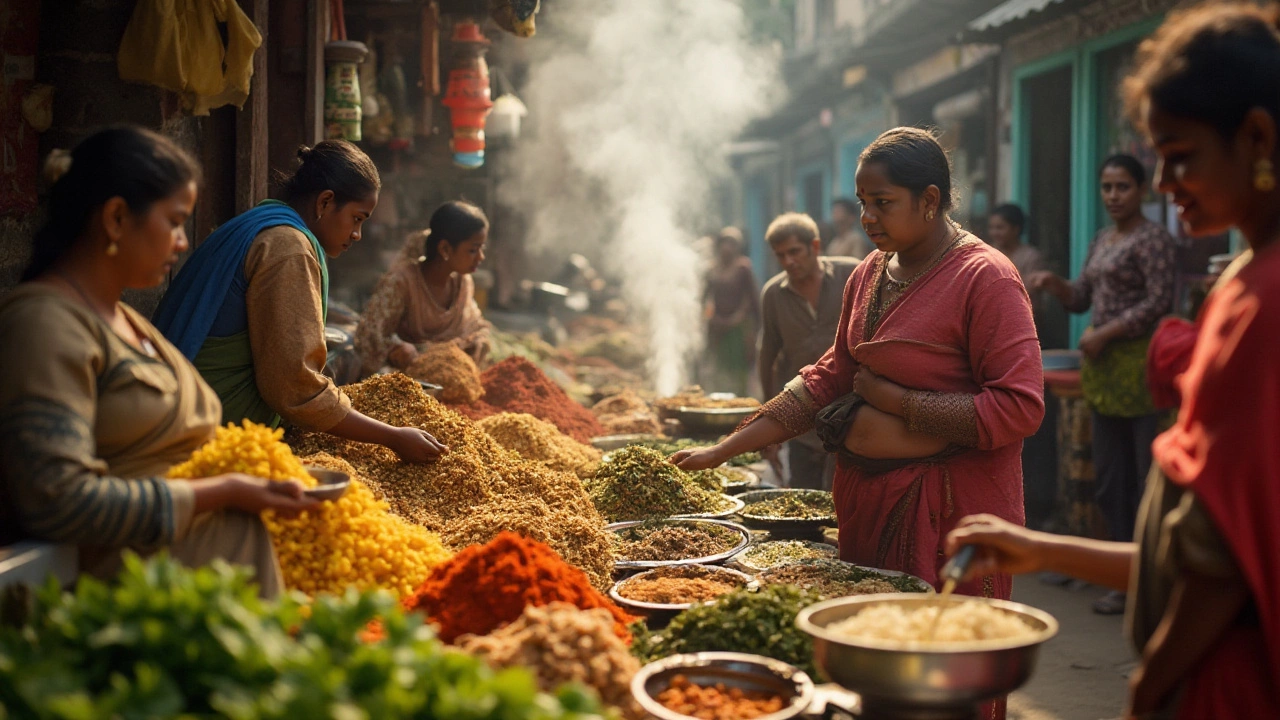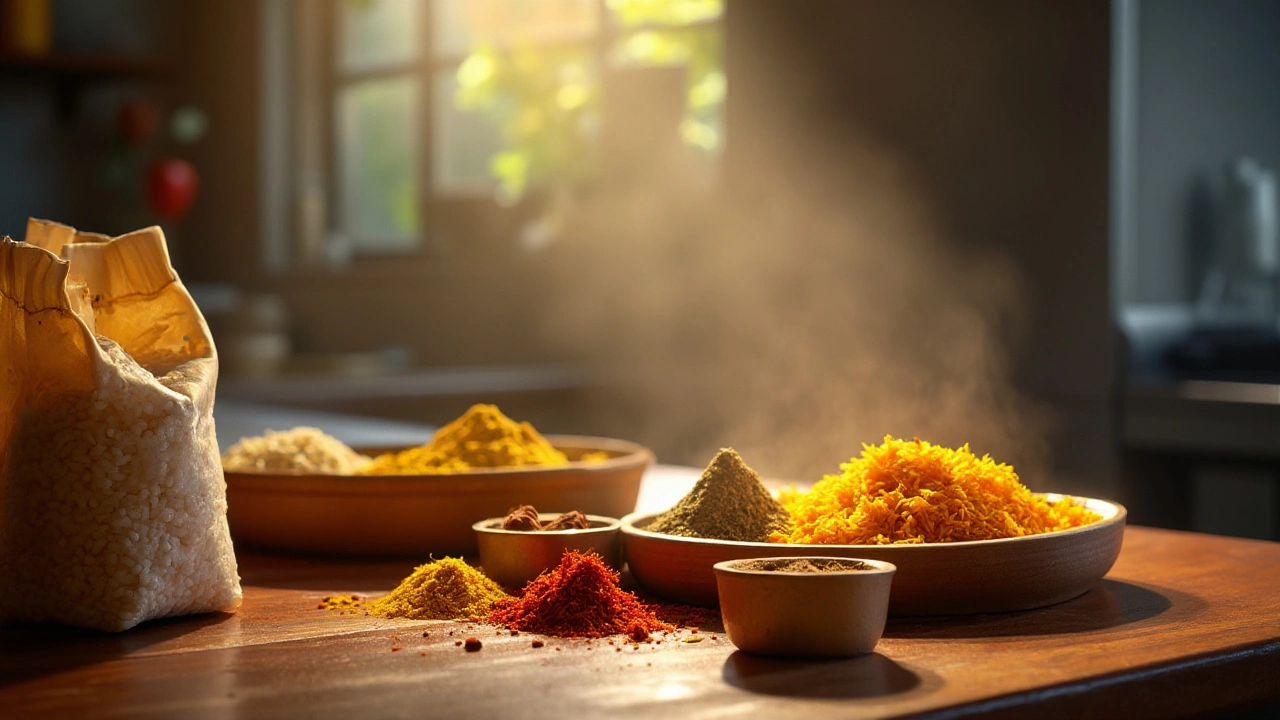Biryani is more than just a dish; it's a savory experience that has woven itself into the fabric of many cultures, each region boasting its unique twist on the traditional recipe. But what makes a biryani truly unforgettable? Could it be the harmony of aromatic spices, or the perfect tenderness of meat enveloped in fluffy grains of rice?
The quest for the perfect biryani begins with understanding its soul: the rice. Opt for long-grained basmati rice, rinsed and soaked to attain its full potential. Then comes the heart of the dish – the spices. Balancing spices is both an art form and a science, requiring a careful hand to ensure each flavor shines through.
Meat choice is another crucial element, whether it's chicken, goat, or beef, ensuring it marinates to absorb those delightful spices. The magic lies in the layering—meticulously arranging the components to cook evenly while retaining their distinct identities.
Let's not forget the symphony of aroma, a result of working with fresh herbs and whole spices, that fills every corner of your home and primes the appetite for what's to come. Join us as we explore these secrets, making every bite of your biryani an overwhelming delight.
- The Importance of Rice
- Choosing the Right Spices
- Quality of Meat Matters
- Layering Techniques
- Secret to Flavorful Aroma
- Common Mistakes to Avoid
The Importance of Rice
When we talk about biryani, we simply cannot overlook the significance of the humble grain that forms its foundation: rice. The quality and type of rice used can make or break the dish. Traditional biryani calls for long-grained basmati rice, renowned for its exquisite aroma, delicate texture, and ability to absorb flavors without losing its structure. The secret lies in the approach to preparing this rice before it even meets the pot. First, rinsing the rice is not just about cleaning it; it's about removing the excess starch that can lead to clumpiness, ensuring each grain remains separate and fluffy.
Soaking the rice is another step where patience plays a crucial role. Allowing the rice to soak for at least 30 minutes in water provides it with the moisture it needs to expand and become tender yet firm, crucial for the layers of biryani. It's akin to brewing a fine tea; each grain blossoms to its full potential with the right treatment. Cooking rice for biryani demands a gentle touch; it should be parboiled or boiled just until about 70% cooked. Achieving this balance ensures that the grains will cook completely when assembled with the meat and spices in the final cooking stage, absorbing the rich flavors and aromas.
The pride of a biryani does not lie solely in its taste but in its appearance too. The perfect biryani boasts rice with no two grains sticking together—a feat achieved by understanding the cooking tips and science of rice. As someone once eloquently put it, "Biryani speaks to your eyes before it whispers to your taste buds."
“The proof of a perfect biryani lies in two things: the aroma and the separation of grains." - Chef Sanjeev KapoorThis separation is particularly crucial as it helps create the aesthetic layers of a well-crafted biryani, making sure each bite offers a medley of textures and flavors.
It's fascinating to note that rice, once undervalued, is now considered the crown jewel of a biryani. The variations in cooking times and methods stem from regional preferences, but the core principle remains the same: excellence. Some chefs prefer adding a few drops of lemon juice or ghee to their rice while boiling, enhancing the fragrant undertones that pair beautifully with the spicy layer. Rice, in biryani, is not just a filler; it is an integral component, demanding attention and respect. When the lid of the biryani pot is finally lifted, the fragrance of perfectly cooked rice, mingling with spices and meat, is nothing short of poetry.
| Rice Type | Characteristics | Usage |
|---|---|---|
| Basmati | Long-grained, aromatic | Ideal for traditional biryani |
| Seeraga Samba | Short and aromatic | Used in South Indian biryanis |
| Jasmine | Sticky, fragrant | Not typically used for biryani |
Choosing the Right Spices
The choice of spices in biryani can differentiate between just another rice dish and an extraordinary feast for the senses. The essence of a good biryani thrives on the rich aromatic blend that transcends ordinary meal preparations. Starting with the basics, cumin seeds and cloves are foundational, imparting a warm and earthy undertone that paves the way for more prominent notes. Cardamom, with its sweet and slightly spicy profile, and cinnamon sticks add a mild sweetness that balances the heat of other spices. These spices should be whole, as freshly ground ones can lose their fragrance and taste over time, detracting from the overall taste.
Turmeric, often referred to as the golden spice, lends not just a glorious hue to the dish but also possesses an earthy aroma that grounds the other flavors. Meanwhile, black pepper introduces a burst of mild heat with citrusy undertones, subtly uplifting the entire dish. For those inexperienced in the world of spices, deepening one's understanding of the symbiotic relationship between each ingredient can open new avenues of taste exploration. Particularly, coriander seeds and star anise should be used sparingly, as their robust flavors can quickly dominate if overused.
According to Madhur Jaffrey, an authority in Indian cuisine, "Spices are the storyteller of an Indian dish, and in a biryani, they narrate a complex saga of flavor, each note building on the other to create a harmonious whole."
Chili powder should be incorporated with caution, blending deftly with other spices to provide warmth without overpowering. Biryani often embraces saffron for its characteristic color and delicate fragrance. When using saffron, it's best to soak the strands in warm milk, helping to unlock its unique flavor profile, which when combined with basmati rice, creates a luxury feel.
Cooking tips also suggest the inclusion of fresh herbs like mint and coriander leaves at the end of the cooking process. These not only wrap the dish with a refreshing layer of scent but also introduce a verdant flavor that elevates the biryani. Patience is paramount; allow the rice and spices sufficient time to harmonize under the slow-cooked steam, perfecting the marriage of flavors. Although the components are few, the secret lies in the balance and timing of their use, ensuring that each spice coexists with its counterparts, creating a biryani that is as memorable as it is delicious.

Quality of Meat Matters
The heart of a good biryani often lies in the type of meat used. Whether you're fortunate enough to savor a delicious lamb biryani or have a preference for the rich flavors of chicken biryani, ensuring that your meat is of high quality is crucial. Start by selecting fresh meat that is neither too lean nor too fatty. The ideal cut should offer a good balance, as this impacts both flavor and tenderness in your final dish. Fresh meat has a distinct freshness that makes a difference in taste, while meat that has been frozen for long can lead to a dry texture.
The marination process is where magic begins, allowing flavors to seep deep within the meat. A mixture typically includes yogurt, a blend of your favorite spices, and some refreshing herbs like mint and coriander. Let the meat marinate for several hours or overnight if time permits. This patience pays off through increased richness and complexity in every bite. Renowned chef Madhur Jaffrey once stated,
'The marination not only tenderizes the meat, but it draws out an incredible depth of flavor.'Her insight reveals why marinating is not a step to be skipped.
Consider the cooking method as equally important. Slow-cooking the meat to perfection is what biryani aficionados aim for, as this process allows flavors to mature and combine. Whether you steam the meat separately or integrate it directly into the rice, ensuring it retains succulence without drying out is key. Some chefs suggest sealing the lid with dough not only to trap the aromas but also to keep the moisture intact during this crucial stage.
Without question, meat quality can make or break a biryani. The choice and treatment of meat have the power to transform a simple dish into something truly spectacular. Remember, selecting the best cut and treating it with love and care during marination and cooking can elevate your biryani to an entirely new level of deliciousness.
Mastering Layering Techniques for Perfect Biryani
The art of layering in a biryani is akin to composing a musical masterpiece, where every element must be perfectly timed and synchronized. This technique involves not just the mere placement of ingredients, but understanding the science of cooking each one to perfection within its own constraints—only to collectively rise to a symphony of flavors. To start, one must prepare all components separately with finesse. Rice, a hero of the biryani, should be par-boiled until it is fluffy yet firm. Simultaneously, the meat must be marinated to sink into a realm of diverse spices and yogurt, tenderizing while infusing depth into every bite.
Once all components are ready, the stage is set to layer these elements in a heavy-bottomed pot to prevent burning. The importance lies in alternating layers of rice and marinated meat to interspice flavors, allowing the aromas to encapsulate within the layers. Begin by spreading a base layer of cooked rice, a thin veil that supports the flavors above. Carefully spoon in the marinated meat, ensuring an even distribution to avoid overpowering certain areas. Repeat, ending with a topcoat of rice adorned with fried onions, fresh herbs, and a sprinkling of saffron-infused milk. For those new to this technique, a 'dum' or steam is applied by sealing the pot with dough or a tight-fitting lid, letting it cook over low heat to tenderize and meld the layers exquisitely.
This technique of layering and steaming creates a veritable fragrance that engages the senses. Gael Greene, a famed food critic, once said,
"Great food is like great sex. The more you have, the more you want."Similarly, a well-layered biryani leaves you craving its intricacies over and over again. Moreover, this method ensures not just flavor but texture diversity as well, with tender meat juxtaposed against the delicate crunch of each rice grain, sealed by the slightly crisp fried onion garnish. It's an ode to culinary balance, a celebration on a plate.
To truly elevate your biryani recipe, consider exploring regional variations that boast unique layering techniques of their own. For instance, the Hyderabadi biryani advocates the use of raw marinated meat at the base, trusting the 'dum' process to cook the meat uniformly amid the spices and basmati aroma. Conversely, the Lucknawi style glorifies pre-cooked meat adorned over well-spiced rice, theorizing its 'Awadhi' roots by prioritizing flavor seepage into the grains above all else. Layering stands central to each method, evolving over centuries whilst upholding its timeless essence.
Actively engaging in these techniques offers insight into the boundless world of biryani, echoing the culture and tradition entrenched within each grain, each spice, within its layered embrace. Knowledge of these secrets is the indispensable key to replicating this classic dish across various interpretations and kitchens worldwide, uniting people from diverse walks of life over a shared gastronomic table.

Secret to Flavorful Aroma
The signature aroma of a well-made biryani is unmistakable, evoking memories of festive meals and cherished gatherings. This celebrated fragrance is not an accident but rather the result of consciously layered techniques and ingredients. The cornerstone of this aromatic orchestra lies in the deliberate choice and combination of spices. Ingredients like cardamom, cloves, star anise, and saffron synergize to create a bouquet that tantalizes the senses. It's important to use whole spices instead of ground ones, as their subtle oils release more naturally and linger longer when they're cooked slowly over low heat, allowing for a gradual infusion of flavors.
The art of blooming the spices, during the initial stages of cooking, ignites their true potential. Premium saffron, a key player in this aroma, is often soaked in warm milk before being added to the rice, lending its warm, earthy scent and a golden hue. Equally, a handful of mint and fresh cilantro contribute a touch of green freshness, creating an engaging dimension to the fragrance profile. A pro-tip from seasoned chefs is to layer fried onions between the rice and meat, whose sweet caramelized notes blend seamlessly into the spiced milieu. "The aroma of biryani, when done right, does not merely announce the meal, it introduces it with an air of ceremony," notes celebrated chef, Madhur Jaffrey.
A technique embraced by many is to include a little rose water or kewra water. In measured amounts, it adds a unique florality without overwhelming the dish. But remember, these elements can be potent, so moderation is key. In a study conducted by the Culinary Institutes, it was found that nearly 68% of aroma perception in food is influenced by freshness and correct balance of these fragrant components (Source: Culinary Institutes Report, 2022). It's not just about reducing the spices to a fine blend; it's about allowing them to sing their notes one after another in a symphony that elevates the dish from appetizing to irresistible. Understanding this symphonic approach to aroma can transform a good biryani into an unforgettable one.
Common Mistakes to Avoid
Creating a perfect biryani is often seen as an art, where precision and passion bring out the best in this beloved dish. However, even seasoned cooks can stumble upon pitfalls that might compromise the taste and texture. One prevalent mistake is using the wrong type of rice, or not prepping it properly. Basmati rice is acclaimed for its long grains and delicate aroma, making it essential for biryani. It should be rinsed thoroughly to remove excess starch, which helps prevent the rice from becoming too sticky. After rinsing, soaking the rice is key to achieving that sought-after fluffy texture.
Next, let's talk about the spices. A dish like biryani relies heavily on a harmonious blend of spices. Yet, newcomers often overdo it or under-season, leading to overpowering flavors or blandness. Using whole spices can immensely enhance aroma, and freshly ground spices can release more potent flavors. An essential tip is to toast the spices slightly in oil or ghee beforehand. This simple step can take the flavors up a notch while ensuring they distribute evenly throughout the biryani.
Layering might seem straightforward, but it plays a pivotal role in how the flavors meld. When assembling your biryani, ensure each layer is distinct; offer a generous layer of rice between layers of meat and spices. This method facilitates uniform cooking, allowing each component to retain its unique flavors while marrying beautifully. An often-ignored step is letting the assembled biryani rest, covered, to let the flavors mature and enrich the entire dish.
Another common error lies in the meat's preparation. Marinade ensures the meat remains tender and flavorful. Skipping or hastily marinating can result in bland or tough meat, which can ruin the overall texture. A rule of thumb—marinate your meat for at least 4 hours, preferably overnight, for the best infusion of flavors.
According to Samia Ahmad, a renowned culinary expert, "In biryani, patience is your best spice. Letting each step absorb your focus and precision makes your dish not just good, but exquisite."
Lastly, the pot you choose should not be neglected. A pot with a tight-fitting lid will ensure steam and moisture remain intact, preventing dryness. Cooking the biryani on a gentle flame compacts the flavors, akin to baking in an oven. Don't stir the biryani once it's assembled; gentle layering ensures the meat doesn't break into pieces, preserving the integrity of the dish.
